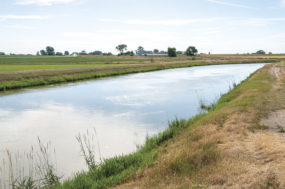The Ford 332-cubic-inch V-8 was the big engine when he started. By the time I drove for Ralph, the 332s had all gone away, and the gasoline rigs ran the Ford 391 V-8 except for one Super-Duty T-850, which ran the 534-cubic-inch V-8. Output was about 275 honest horsepower at 3,200 rpm. I didn’t get in that one much, but I loved it when I did. It took a little more fuel than the 391s, but the trip times were noticeably shorter.
The 391s were good for about 3.5 miles per gallon, and the 534 about 3 miles per gallon on a good day. That’s a better perspective than saying the 534 engines only got half-a-mile per gallon less than the smaller-engined trucks.
Ralph’s choice for diesel trucks was Mack Maxidyne when he added diesel power to the fleet. The six-cylinder trucks put out 237 horsepower, but the torque was over 900. It took some doing to get accustomed to the straight five-speed transmission that was behind the Maxidyne, but that “little” engine would pull down to 1,100 rpm before it needed shifting to a lower gear. They ran with the truck traffic of the day, and on a hill it would easily outpull competing engines of higher horsepower.
The stars of Ralph’s fleet were two F-model Macks with the 325-horsepower Maxidyne V-8. Back then (early 1970s), the V-8 Macks were up there among the kings of the road.
How times have changed. Now, it’s hard to get an experienced driver to even talk to you about a driving job if your equipment isn’t running at least 500 horsepower.
Brakes, for which to slow down and stop a big rig, are a different discussion.
Let’s start by talking about your automobile. When an “I should’ve stayed in bed” situation shows up in front of you (in the hay hauler jargon), the thing to do is “dynamite” the brakes. This will make the wheels slow, sometimes stop, and slow and eventually stop the vehicle. Under the hood of your car, if you can find the brake master cylinder, there will be two output brake lines, one to power the front-wheel brakes and the other the rear.
Under emergency braking, much of the weight of the vehicle will shift to the front wheels, leaving little comparative weight on the rear. If equal pressure is applied to the front and the rear wheels, then the rear wheels will stop turning, slide, lose traction and cause the vehicle to swap ends. This is not good.
The two lines to the front and rear wheels operate at different pressures so both sets of wheels stop turning at the same time. This leaves the scared-spitless driver with a better chance to come to a controlled stop.
Combination vehicles – that is, those with a power unit and trailers pulled behind – make the braking issue more interesting. Realize that when a wheel stops turning and starts sliding, it has lost traction and is now sliding. It will – on dry pavement, loose gravel or ice and snow – follow momentum downhill.
By either accelerating, steering or braking, the idea is to keep the tires turning on the road surface. Loss of traction is never a good thing.
A combination vehicle, a truck or pickup pulling one or more trailers, needs to have the brakes on the rear-most axle apply just milliseconds before the brakes apply on the next axle toward the front of the vehicle. In combinations, the actual application of braking force to the front (or steering axle) should be the last axle receiving braking force.
This helps prevent “jackknifing,” or the rear unit (trailer) pushing the power unit out of a straight line and making the combination of power unit and trailer fold up like closing a pocketknife. If there is any “downhill” to the surface you are driving on, that is where your party will end up.
Plan “A” is to drive far enough behind other traffic so one never needs to “dynamite” the brakes. Then a gentle application of the brakes will allow all the wheels to slow at the same time, resulting in a controlled stop. Once the gentle application has happened, in most cases, a more robust application can follow with things still maintaining control.
“Drag it down the hill” is the best way to describe finding safety when, after you are past the point of no stopping to chain up, conditions change and ice is underfoot. The right side of the roadway may have some remaining sand or at least some snow that has not compacted into an excellent ice-skating surface.
A tiny bit of power from the power unit and a tiny bit of braking force to the wheels of the trailing unit and speed as slow as possible is the only way I can describe the process. I had more than one helper stare in disbelief as I told him to roll down his window and look back and watch the trailer, and tell me if it looks like it’s trying to pass the truck on his side.
After getting to the bottom, they usually made some form of comment like, “Hey, boss, how’s about we don’t do that any more?” ![]()










